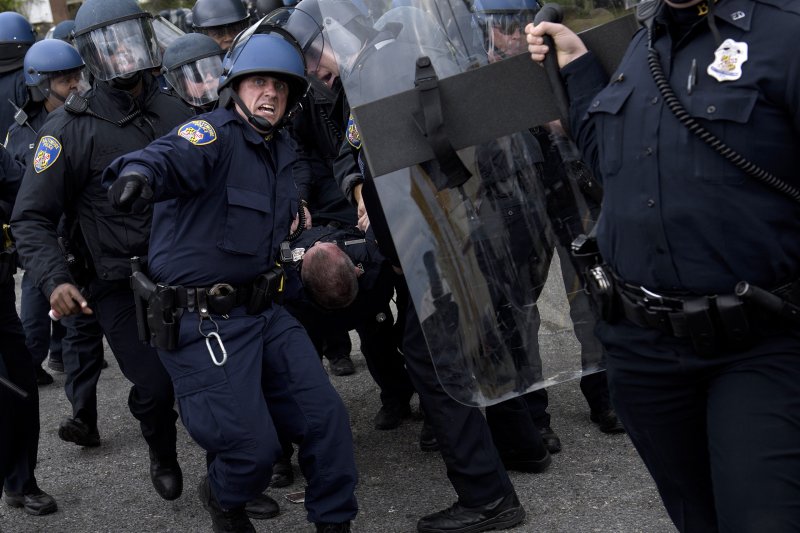BALTIMORE — When Elijah Cummings’s calm baritone came through a police bullhorn Tuesday night urging Baltimore residents to abide by a curfew and head home, young men in the street responded, “Fuck you!”
Cummings, a congressman and a stalwart of Baltimore’s black community generally seen as representative of the progress made by the 1960s civil rights movement, was viewed by some Tuesday night as just another agent of the state. Those same people were the ones who wrapped their faces in bandanas and defied a curfew, causing police to resort to pepper balls and tear gas to disperse the crowds.
Governor Larry Hogan even declared: “We’ve turned a corner,” before adding it’s not over.
The curfew didn’t work though, unless the objective was to bully people back into their homes with the eye-stinging agents that more police departments may have to use if they keep unnecessarily killing black men.
The curfew provided a time—and the massive police presence at the intersection of North and Pennsylvania provided a place—for those intent on clashing with police to do it. And that’s exactly what they did. Play-by-play, what happened Tuesday night in Baltimore was the same sequence of events that occurred in Ferguson when authorities instituted a curfew there, with one notable exception. The National Guard was deployed following Monday’s unrest, unlike in Ferguson where the Guard didn’t show up until the second night of the curfew. The deployment prompted hope that the Guard’s presence would quell any further rioting. There was just one problem: There was no National Guard in Sandtown.
“They got the damn National Guard down there in Inner Harbor, defending white Baltimore,” one man said, going hoarse from frustration and anger that couldn’t be controlled anymore.
There was quite a bit of political wrangling over the deployment of the Guard and their position in Inner Harbor may have been a tactical one, waiting in reserve in case the situation got out of hand elsewhere.
It wasn’t until well after the clashes with police that the Guard showed up at North and Penn, but by then it was too late.
“The governor wanted the Guard down there to assert presence,” even as city cops were asking for their help elsewhere, a military source familiar with Baltimore operations told The Daily Beast.
So the Maryland National Guard activation was, at least on Tuesday evening, mostly for show.
They were defending the city’s real investment, according to Quintin Reid, the bail bondsman who freed Freddie Gray from jail twice before his death. Downtown now gleams with Camden Yards (closed to the public for today’s baseball game), hotels, shops, restaurants, and bars that the people of Sandtown don’t often patronize.
“The well-to-do whites and blacks, they wanted them to be in the city and be a tax base,” he said. “But they don’t need no tax incentives, they the ones holding the money!”
Reid holds Mayor Stephanie Rawlings-Blake in specific contempt.
“We have black leadership, and look what they’ve done” Reid said. “Politics is a study of power, and that’s exactly what this is.”
For some on Tuesday night it was the memory of Freddie Gray that prompted them to take to the streets. For a lot of others it was the conditions in which they live that were the larger issue, with Gray’s death serving as the spark that lit the fire.
“This is pain caused from poverty erupting. This is pain exploding,” said Tony Burks, a 38-year-old lifelong resident of Baltimore who spent a bit of time Tuesday night trying to convince a camera crew to turn on their machines so he could have his say. Burks wanted outsiders to know why this was happening, why kids took to the streets Monday to burn and loot and why a few stuck around Tuesday night to make sure the cops knew this was their neighborhood, and that they weren’t going to be told when to go home.
“What the fuck are they supposed to do? Look around you,” Burks said, pointing to the block of abandoned row houses behind us, the night sky peeking through roofs that have fallen because of decades of neglect, not the fires that made headlines this week.
Photos: Scenes From the Chaos in Baltimore
“Imagine how it would make you feel walking down the street to this every day. These kids feel like they have nothing.”
The same man decrying the National Guard’s defense of Inner Harbor was as enraged at the media’s presence as much as he was the cops in riot gear. He went on an extended diatribe for his fellow residents and in the faces of reporters who found themselves on the receiving end of a speech that in many ways represents the conflict in Baltimore.
“Point your camera at them! They got a sniper pointed at us, so point the cameras at them!” he said. A few feet away, a cop in war gear peered from the top of an MRAP with an assault rifle at the ready. The cameras stayed on the man.
“They kill a black man and don’t answer for damn near a month, but we riot one night and look what happens!” he said, pointing to the line of stone-faced cops behind clear plastic shields.
It’s impossible to tell what would have happened if the cops there, at North and Penn, had been replaced by the National Guard. Maybe it would have displaced some of the rage. After all, it wasn’t the National Guard who was responsible for Freddie Gray’s death. It was the Baltimore Police Department, lined up in blue on Tuesday night in Sandtown to keep order, the only way they knew how.
















